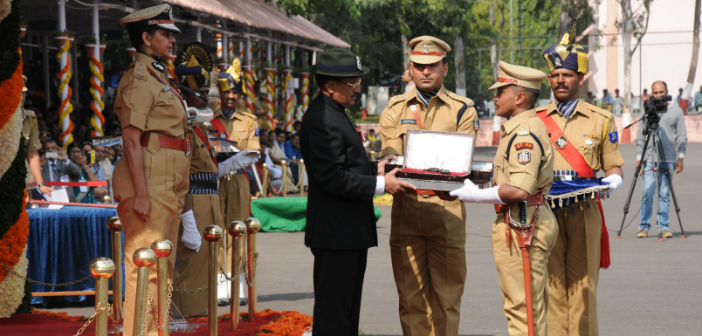Odisha, Jammu & Kashmir, Karnataka & West Bengal face a severe shortage of IPS Officers

[orc]The Indian Police Service (IPS) is one of the three All India Services constituted under Article 312 of the Constitution of India. They provide senior leadership to the police force. For quite some time now, the IPS has been facing a severe shortage of officers. As on 01st January, 2015, there is a shortage of 19% of IPS officers against a sanctioned strength of 4754.
The Indian Police Service (IPS) is one of the three All India Services constituted under Article 312 of the Constitution of India. The IPS officers provide senior level leadership to Police Forces both in the States and at the Centre. The Service is organized in 24 State cadres, reviewed after every 5 years. The sanctioned strength of the IPS officers is 4754 as on 1st January, 2015. Against this sanctioned strength, only 3848 officers are in position, resulting in a shortage of 19%.
The IPS Recruitment – Three different modes
The recruitment for IPS is done through the following three different modes
- Direct Recruits: These are recruited based on their performance in the Civil Services examination conducted by the UPSC.
- Promotion of State Police Officers: Every year, State Police Service Officers (SPS) are inducted into the IPS via the promotion process.
- Limited Competitive Examination: Officers of the rank of Dy. SPs of State Police Services, Assistant Commandants of Central Para-military Forces and Captains and Majors of Defence Forces fulfilling certain eligibility criteria are eligible for appearing in the aforesaid examination for recruitment to IPS.
To fill up vacancies, the batch size of the direct recruits has been increased to 150 from 2009. Besides the direct recruits, a total of 441 State Police Service Officers have been inducted into the IPS from 2012 to 2014. The Limited Competitive Examination is mired in controversy and a large number of Court Cases have been filed challenging this mode of recruitment.
Odisha, Jammu & Kashmir, Karnataka & West Bengal face a severe shortage
Against the sanctioned strength of 4754, there are only 3848 officers in position (including all modes of recruitment), resulting in 19% vacancies. Within states, Odisha faces the most shortage with 42% (79 posts are vacant against a sanctioned strength of 188). Jammu & Kashmir faces a one-third shortage of officers. Karnataka & West Bengal face close to 30% shortage. Uttar Pradesh faces a one fourth shortage. North Eastern states like Nagaland & Manipur also face a severe shortage.
The largest cadres face varying degrees of shortage. Uttar Pradesh faces a 1/4th shortage while West Bengal faces about 28% shortage. Maharashtra faces about 20% shortage. Madhya Pradesh faces only 16% shortage. The AGMUT cadre (Arunachal Pradesh-Goa-Mizoram-Union Territories) faces around 18% shortage. A total of 14 cadres face a shortage less than the national average while the remaining face a shortage greater than the national average.
Is the recruitment process in line with the Vacancy Position?
The numbers for direct recruitment & promotion indicate that the process of recruitment does not necessarily follow the vacancy position. States like Odisha, Jammu & Kashmir & Karnataka have had very low recruitment despite a high vacancy percentage while states like Rajasthan Bihar & Madhya Pradesh have had high recruitment despite lower than average vacancy percentage.
|
S No |
State/Cadre | Direct Recruits
(2011 to 2013) |
Promotion of SPS
(2012 to 2015) |
Vacancy Percentage as of
01-01-2015 |
| 1 | Uttar Pradesh | 52 | 52 | 25% |
| 2 | AGMUT | 35 | 20 | 18% |
| 3 | West Bengal | 34 | 42 | 28.2% |
| 4 | Maharashtra | 29 | 52 | 20.5% |
| 5 | Madhya Pradesh | 26 | 33 | 15.8% |
| 6 | Tamil Nadu | 24 | 25 | 17.9% |
| 7 | Rajasthan | 14 | 45 | 12.7% |
| 8 | Bihar | 21 | 36 | 17.7% |
| 9 | Odisha | 15 | 0 | 42% |
| 10 | Jammu & Kashmir | 11 | 0 | 33% |
| 11 | Karnataka | 20 | 0 | 28.8% |
The Kamal Kumar Committee Report found the process of fixing cadre strength as Unscientific
A committee under the chairmanship of Mr. Kamal Kumar was tasked with coming up with a recruitment plan for the IPS. The committee submitted its report outlining the recruitment plan from 2009-2020. The committee found the following to be some of the causes for shortage of the IPS officers among others.
- Low intake of Direct Recruits over Several Years
- Unscientific process of fixing cadre strength (Sanctioned Strength)
- Periodicity of Cadre Review
The committee recommended the following measures for reducing the shortage of IPS officers.
- Thorough revamp of the cadre review process for the IPS. The process, at present, is too slow, complicated and cumbersome. It needs to be made more realistic, scientific as well as expeditious.
- The periodicity of cadre reviews for the IPS should be reduced from the existing 5 years to 2 years.
- In the process of recruitment of a large number of IPS officers to meet the acute shortages, any compromise with the quality of recruitment or training of new inductees has to be avoided. A balance should also be struck between (i) the need to fill up the vacancies with urgency, and (ii) the consideration of avoiding problems of cadre management and career progression of officers, in future.
- Combination of three sources of recruitment (Direct, Limited competitive examination and appointment of professionals from specialized fields such as IT, Communications etc)
Featured Image: Sardar Vallabhbai Patel National Police Academy for representation purposes only.